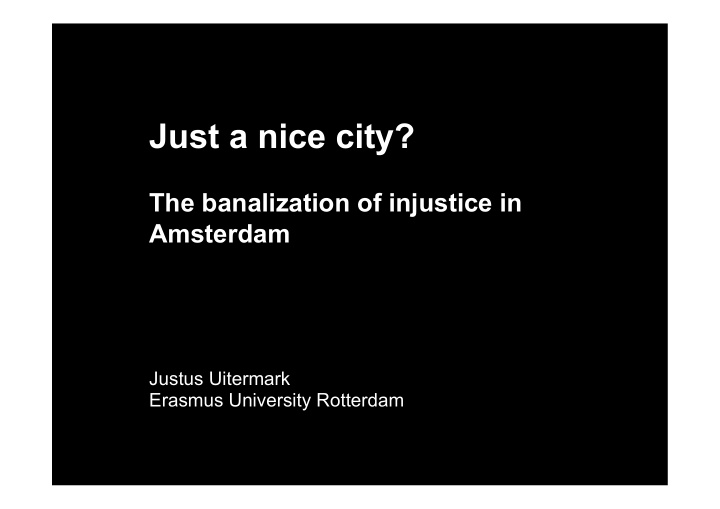



Just a nice city? The banalization of injustice in Amsterdam Justus Uitermark Erasmus University Rotterdam
Amsterdam: the ideal/just city John Gilderbloom: People in Amsterdam are “more tolerant, secure, happier, and healthier compared to citizens in the United States... Amsterdam, at this moment in history, might be the world's greatest city because of its ability to ensure basic necessities, freedom and creativity”. Susan Fainstein in The Just City : “Amsterdam presents a rough image of a desirable urban model”
This presentation's questions Why and to what extent is Amsterdam an ideal city? Why and to what extent is Amsterdam a just city? How, if at all, should science contribute to bringing about the just city?
Tolerance as control: the gedoog policy
The advance of modernism from the East
Radicalizing neighborhood protest
Ca 1979: The birth of the just city - The new motto of urban renewal: “building for the neighborhood - The residents were now in control of the reconstruction of the neighborhoods - Private housing was transformed into social housing - The access to social housing was universalized Wonen is geen gunst maar een recht – "housing is a right, not a favor”
2011: the eviction of the last automous social center in the city
The banality of injustice in the post-political city Urban renewal: - Tenants are compensated with 5000 euros and an urgency status - Vacant buildings are filled with with (gentrification-promoting and easily disposible) anti-squatters - Liveability is perceived to be proportional to the share of middle class households - Measures objectify displacements as a contribution to liveability Coffeeshops: - Plans for registration and discrimination - “Die-out policy” - Opposition based on arguments of order, not principle
Propositions on science and critical science The role of scientists 1. We need to effectuate a break with instrumental research to focus on theory driven research The role of critical scientists 2. Critical scientists need to crack the black boxes 3. Develop alternative urban imaginations
It appears that justice as a specter for urban planning has been on the demise. There is now talk of diversity, liveability, creativity, mixing, and so on. Do you see a place for justice in the planning of Amsterdam today and in urban planning in general?
Is there is a distinction between science and critical science? What is the kind of science that RC21 should promote?
We probably agree that Amsterdam compares favorably to other cities with respect to social justice. But do you think that this city, or any city, can be held up as a ‘model’?
Urban studies is not in short supply of criticism but it does appear to lack inspiration. Where can we look for forms and practices that provide alternatives to current cities?
Questions It appears that justice as a specter for urban planning has been on the demise. There is now talk of diversity, liveability, creativity, mixing, and so on. Do you see a place for justice in the planning of Amsterdam today and in urban planning in general? Is there is a distinction between science and critical science? What is the kind of science that RC21 should promote? We probably agree that Amsterdam compares favorably to other cities with respect to social justice. But do you think that this city, or any city, can be held up as a ‘model’? Urban studies is not in short supply of criticism but it does appear to lack inspiration. Where can we look for forms and practices that provide alternatives to current cities?
Recommend
More recommend